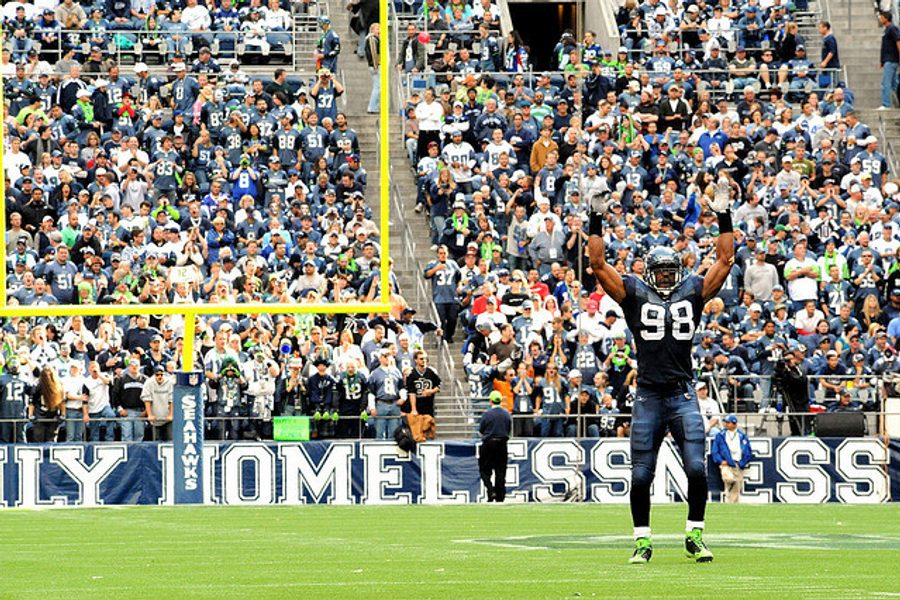The Super Bowl’s Violence Is America’s Violence
Connecting the dots between football and the violence throughout our society might tell us more than we care to know about ourselves.
Theo Anderson and Joshua Salzmann

When our unofficial national holiday, Super Bowl Sunday, comes and goes, it will mark the end of one the most remarkable NFL seasons in many years — a season dominated by uproars over deflated footballs, brain injuries and graphic evidence of Ray Rice cold cocking his fiancé and Adrian Peterson beating his son.
The focus on fair play and brutality in football has been paralleled by broader discussions about fairness, violence and the behavior of law enforcement in poor communities over the past few months. Yet those discussions have rarely intersected. And for many Americans, there is good reason for keeping the violence of the gridiron separate from the violence of the streets: Connecting the dots might tell us more than we care to know about ourselves.
Sports are more than games. They reflect core values and social tensions, a point made by anthropologist Clifford Geertz in his famous 1972 study of Balinese cockfighting. Geertz showed that cockfights were a form of “deep play” that simulated clashes between social groups. Similarly, historian Elliott Gorn has shown that men in the rugged colonial American backcountry embraced the violence of their society through sports such as “eye gouging,” in which rivals pummeled each other until one ripped his opponent’s eye from its socket.
Football is our distinctively American deep play, a sport in which magnificent athletes slowly crush and cripple each other in front of sold-out crowds. The brutality sometimes takes disconcerting forms. From 2009 to 2011, defensive players on the New Orleans Saints paid “bounties” to comrades who injured opposing players. But injury occurs regardless of intent. We now know that football collisions cause brain damage, and that this on-field violence easily bleeds into other areas of life.
The NFL has downplayed incidents of players abusing women and kids, and its response to the crisis of head trauma has been to offer a reward for a safer helmet design. This is hardly surprising. The NFL is a highly profitable and rapidly growing business, with its commissioner Roger Goodell stating that he has the goal of reaching revenues of $25 billion by 2027. It has interests to protect.
But what’s our interest in playing along?
Violence is our culture’s libido, freely celebrated while also suppressed. The institutions most devoted to celebrating it, the military and the NFL, are also among the most revered. Football is our most popular sport — about half of Americans self-identify as fans — and the military constitutes about a fifth of our federal budget. Football’s ability to foster the warrior spirit — “clear eyes, full hearts, can’t lose,” as the show Friday Night Lights puts it — presumably justifies the brutality inherent in the game.
But while we celebrate and reward violence when it takes these forms, and is sponsored by these institutions, we either condemn or turn a blind eye to the violence of the streets.
Spectacular cases of gun violence receive the most attention, and they usually involve shooting sprees on school campuses. But in our nation’s poorest neighborhoods, there is the equivalent of a mass shooting, or the real potential for one, every day. In one weekend last July, 13 people died and 58 were wounded by gunfire in Chicago, where such bloodshed is so routine it hardly merits comment beyond the local media.
For young people growing up in this hostile environment, the lure of professional sports is powerful. This is especially true for African Americans, who make up just less than 13 percent of the population but 67 percent of NFL players.
They choose to play the game and are paid fabulous sums. But their choices are narrowed by our refusal to honestly address the power, wealth, and opportunity inequalities that leave certain people with few options. Violence, in whatever form, is their best hope of survival. Gangs offer protection and community. Military service promises upward mobility. The NFL holds out the hope of magnificent wealth and fame. All demand the sacrifice of young male bodies.
Societies have long exploited the poor for pleasure and profit. In this respect, Americans exhibit the same callousness that Jonathan Swift satirized in his famous 1729 essay “A Modest Proposal,” which encouraged the wealthy to eat poor Irish babies to alleviate poverty.
We are unlikely to follow Swift’s recipe. Yet we routinely condemn poor kids to communities where prison is a common destination and death by violence is an ever-present possibility. That reality isn’t exclusive to black neighborhoods, certainly, but it is most striking in them. A third of black men end up in prison in the U.S., and young black men are 21 times more likely than young white men to be killed by police.
It might soothe our conscience to deny the connection between the violence of our streets and the brutality of the NFL. But let’s at least have the courage to see our reflection in our favorite sport.
A clear-eyed assessment would take us to a dark conclusion: Football genuinely enacts our values and priorities. It reflects and feeds on deep social and economic inequality. We ask athletes, disproportionately young black men, to perform mock warfare for our amusement. If the violence that ensues (on and off the field) is disturbing, building a better helmet is hardly the answer. We should focus instead on building a better society.
If not, we shouldn’t be prissy about brain injuries and the crimes of the NFL’s latest (or next) perp. Maybe, instead, the NFL should amplify the violence and give America the kind of deep play that it truly deserves. Bounties for broken bones, perhaps? That would draw a clearer connection between the brutality and the big salaries. Perhaps some eye-gouging along the line of scrimmage? The horrors of the game would be more immediate and grotesque, unlike the creeping brain damage that so many ex-NFL players endure.
Outrageous? Sure. But hardly more outrageous than the violence we so willingly celebrate — and ignore — already.




